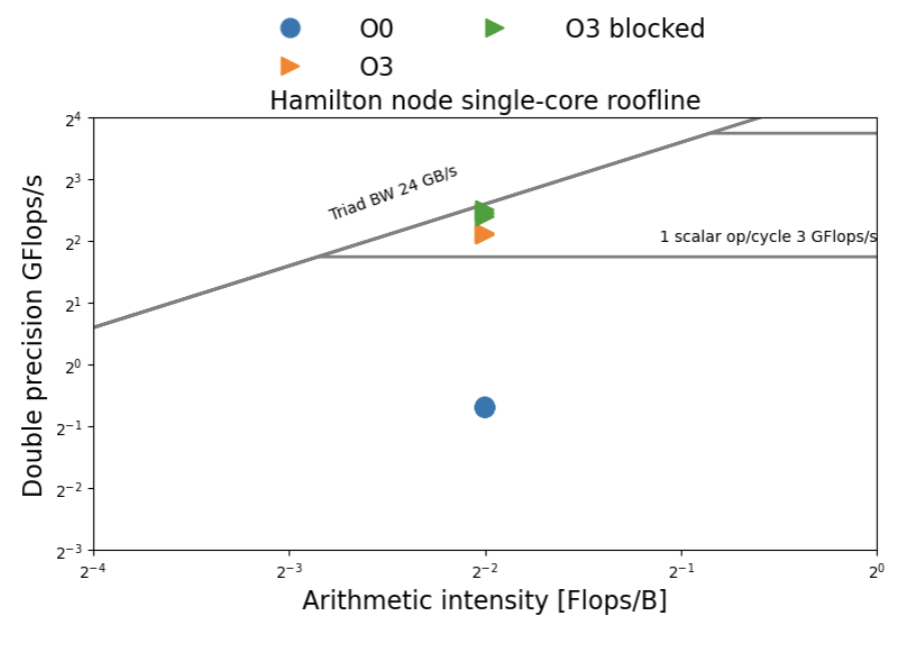Performance Measurements
Performance Measurements
SESSION 4 Performance Measurements
Overview
Roofline
- comparison between hardware configurations
- high-level overview of code performance
- general guidance for optimisation
Measurements
- to get more information about bottleneck
- to confirm the hypothesis formed through roofline analysis
Exercises 4: roofline for matrix-vector multiply
Goal:
\[y = Ax = \sum _{j=1}^{n_{col}} A_{ij} * x_j\]Performance measurements
Special purpose registers:
- common in modern hardware
- record low-level performance events
- number of Flops of different type (scalar, sse, avx)
- cache miss/hit counts at various levels
- branch prediction success rate
- …
- can be overwhelming
- best used to confirm hypothesis from some model
Caveats
- Information about
- the algorithm you implemented
- the way you implemented it
- the data moved in the measured run
- Does not consider
- potentially better algorithms
- potentially superior ways of implementing those
- data you could have moved in a different run
Only meaningful as complements to models.
Granularity
- Direct read of low-level hardware counters
- most detailed
- hardware dependent
- not portable
- Abstract metrics
- groups of low-level counters
- easier to compare across hardware
“instructions” → “instructions per cycle”
How do we measure them?
- Use
likwid-perfctr(installed on Hamilton via the likwid module). - Offers a reasonably friendly command-line interface.
- Provides access both to counters directly, and many useful predefined “groups”.
- Will use
likwid-perfctrto measure memory references in different implementations of the same loop.
Example: STREAM
Scalar
1
2
3
4
5
6
7
for i from 0 to n:
- load a[i+1] reg1
- load b[i+1] reg2
- load c[i+1] reg4
- mul reg1 reg2 reg3
- add reg4 reg3 reg4
- store reg4 c[i+1]
SSE
1
2
3
4
5
6
7
for i from 0 to n by 2:
- vload a[i+2] vreg1
- vload b[i+2] vreg2
- vload c[i+2] vreg4
- vmul vreg1 vreg2 vreg3
- vadd reg4 reg3 reg4
- vstore reg4 c[i+2]
AVX
1
2
3
4
5
6
7
for i from 0 to n by 4:
- vload a[i+4] vreg1
- vload b[i+4] vreg2
- vload c[i+4] vreg4
- vmul vreg1 vreg2 vreg3
- vadd reg4 reg3 reg4
- vstore reg4 c[i+4]
AVX2
1
2
3
4
5
6
for i from 0 to n by 4:
- vload a[i+4] vreg1
- vload b[i+4] vreg2
- vload c[i+4] vreg3
- vfma vreg1 vreg2 vreg3
- vstore reg3 c[i+4]
Measurement
Model For $N = 10^6$, how many loads and stores in each case?
Answer Each loop iteration has 3 loads and 1 store.
With vector width $W$ and $N$ iterations we need:
- $\frac{3N}{W}$ loads
- $\frac{N}{W}$ stores
Exercise 5: Models and measurements
- Download the STREAM TRIAD benchmark
- Compile with
likwidannotations - Measure loads and stores
- Ask questions!
This post is licensed under CC BY 4.0 by the author.
